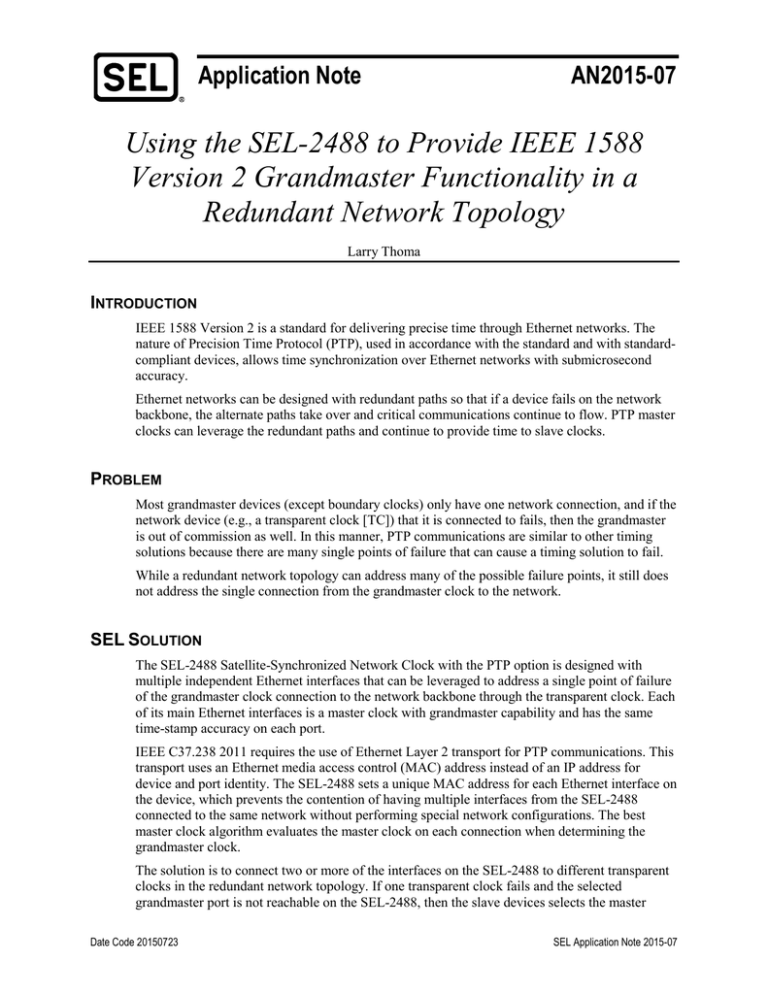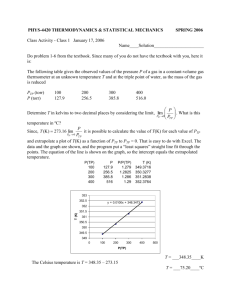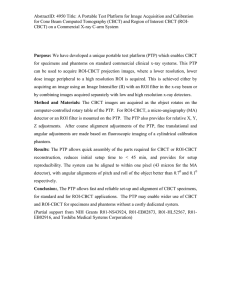
Application Note
AN2015-07
Using the SEL-2488 to Provide IEEE 1588
Version 2 Grandmaster Functionality in a
Redundant Network Topology
Larry Thoma
INTRODUCTION
IEEE 1588 Version 2 is a standard for delivering precise time through Ethernet networks. The
nature of Precision Time Protocol (PTP), used in accordance with the standard and with standardcompliant devices, allows time synchronization over Ethernet networks with submicrosecond
accuracy.
Ethernet networks can be designed with redundant paths so that if a device fails on the network
backbone, the alternate paths take over and critical communications continue to flow. PTP master
clocks can leverage the redundant paths and continue to provide time to slave clocks.
PROBLEM
Most grandmaster devices (except boundary clocks) only have one network connection, and if the
network device (e.g., a transparent clock [TC]) that it is connected to fails, then the grandmaster
is out of commission as well. In this manner, PTP communications are similar to other timing
solutions because there are many single points of failure that can cause a timing solution to fail.
While a redundant network topology can address many of the possible failure points, it still does
not address the single connection from the grandmaster clock to the network.
SEL SOLUTION
The SEL-2488 Satellite-Synchronized Network Clock with the PTP option is designed with
multiple independent Ethernet interfaces that can be leveraged to address a single point of failure
of the grandmaster clock connection to the network backbone through the transparent clock. Each
of its main Ethernet interfaces is a master clock with grandmaster capability and has the same
time-stamp accuracy on each port.
IEEE C37.238 2011 requires the use of Ethernet Layer 2 transport for PTP communications. This
transport uses an Ethernet media access control (MAC) address instead of an IP address for
device and port identity. The SEL-2488 sets a unique MAC address for each Ethernet interface on
the device, which prevents the contention of having multiple interfaces from the SEL-2488
connected to the same network without performing special network configurations. The best
master clock algorithm evaluates the master clock on each connection when determining the
grandmaster clock.
The solution is to connect two or more of the interfaces on the SEL-2488 to different transparent
clocks in the redundant network topology. If one transparent clock fails and the selected
grandmaster port is not reachable on the SEL-2488, then the slave devices selects the master
Date Code 20150723
SEL Application Note 2015-07
2
clock on another interface on the SEL-2488 as the grandmaster. The PTP traffic routes through
the reconfigured network architecture. Each of the SEL-2488 interfaces connected to the
redundant network is configured with similar PTP master parameters (domain, priority, and so
on). This leaves the clock identity, which is based on the MAC address, to be the tie breaker for
which interface is selected as the grandmaster. When the original interface is restored and visible,
the best master clock algorithm recognizes the restored interface as an available master with no
intervention.
To guard against the failure of the SEL-2488, a second SEL-2488 can be connected in the
redundant network topology, as shown in Figure 1. If the active SEL-2488 grandmaster fails, the
best master clock algorithm selects the redundant SEL-2488 as the grandmaster with no
reconfiguration of the solution.
IED (PTP Slave)
IED (PTP Slave)
TC
TC
TC
TC
SEL-2488
TC
TC
SEL-2488
TC
TC
TC
TC
IED (PTP Slave)
IED (PTP Slave)
Figure 1 Redundant Ladder Network Topology
Figure 1 shows typical redundant interconnect topology. Rapid Spanning Tree Protocol (RSTP) is
enabled to manage the switch network. In this network, each SEL-2488 is connected to two
transparent clocks, providing failure protection for multiple scenarios. Optionally, the slave
clocks (intelligent electronic devices [IEDs]) are shown with multiple connections to the network
for the same reason.
In the event of a network reconfiguration due to a device failure, the time it takes to reconfigure
the network is typically a few milliseconds. PTP only transmits timing messages at a one-persecond rate per IEEE C37.238 requirements. Therefore, a single message may be lost, but there
will be no effect on the PTP timing solution.
SEL Application Note 2015-07
Date Code 20150723
3
Under normal operation, the PTP traffic routes as illustrated in Figure 2.
Active Path
Inactive Path
SEL-2488
TC
TC
SEL-2488
TC
TC
IED (PTP Slave)
IED (PTP Slave)
Figure 2 Normal Operation
Figure 3, Figure 4, Figure 5, and Figure 6 show various failures and the automatic reconfiguration
(network and best master clock algorithm) that occurs to reroute traffic and to maintain PTP
master-slave communications.
Figure 3 demonstrates the reconfiguration of the network and how PTP signals are maintained
during a root switch interruption.
SEL-2488
X
TC
TC
SEL-2488
TC
TC
IED (PTP Slave)
IED (PTP Slave)
Figure 3 Root Switch Failure—Use Alternative Path
Figure 4 demonstrates the reconfiguration of the network and how PTP signals are maintained
during a ladder switch interruption.
SEL-2488
TC
TC
SEL-2488
X
TC
IED (PTP Slave)
TC
IED (PTP Slave)
Figure 4 Ladder Switch Failure—Use Redundant Path
Date Code 20150723
SEL Application Note 2015-07
4
Figure 5 shows that the PTP slave device continues to operate and receive time through the
alternate port during a primary port interruption.
SEL-2488
TC
TC
SEL-2488
TC
TC
X
IED (PTP Slave)
IED (PTP Slave)
Figure 5 IED Port Failure—Use Alternative Port
Figure 6 shows that the PTP timing continues during a primary clock failure. The redundant clock
provides PTP time signals when it recognizes that the primary clock is no longer sending signals
to the network (within 2 to 3 seconds of the failure).
SEL-2488
TC
TC
X
SEL-2488
TC
IED (PTP Slave)
TC
IED (PTP Slave)
Figure 6 Clock Failure—Use Redundant Clock
CONCLUSION
With four main Ethernet connections to the device, the SEL-2488 provides a solution to many
cases of a single point of failure on the network. A single SEL-2488, when connected in the
manner described in this application note, will continue to provide PTP time to the end devices,
even with a primary network switch failure. Adding a second SEL-2488 provides redundancy for
the grandmaster clock, making the PTP timing backbone fully redundant.
© 2015 by Schweitzer Engineering Laboratories, Inc.
All rights reserved.
*LAN2015-07*
SEL Application Note 2015-07
Date Code 20150723







